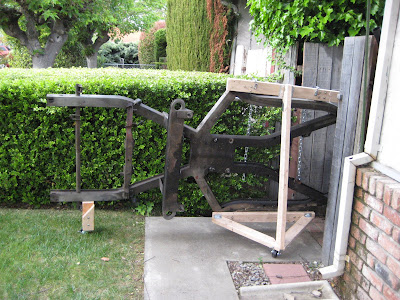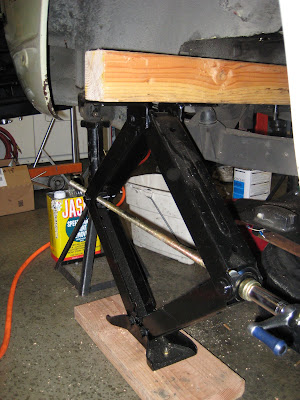the RATCO frame was nearing completion. It was time
to remove the original frame. Although it had served
well (with a few notable exceptions) for almost 40
years, it simply had to go.
The front and rear lifting jacks are in place, the lift bar is ready to go and the engine hoist and load leveler have been positioned and hooked up.

A close shot of the lifting bar shows how it was attached to the engine hoist. Note the really cool swiveling hoist rings (1000 pound capacity!). Each of the hoist rings were chained to the load leveler, which was in turn attached to the hoist via yet another hoist ring, this one rated at 4000 pounds!
A better shot of the load leveler. The leveler allowed us to control the lateral attitude of the front of the tub.

The tub has parted company with the frame for the first time since it was first set on it all those decades ago.

Kind of a cool shot low and from the rear. You can see how the lifting jacks were used to control the rear lateral attitude, a bad attitude right now. The jacks had to be raised in unison, one person on each side cranking a jack. Front and rear had to be kept fairly even also. All in all it worked really very well and we were both quite pleased with ourselves.

The idea was to raise the tub just high enough so that the diff bridge would clear the beam of the front lifting jacks. This shot shows the very rear of the frame, that's the spare tire compartment and part of the rear diff mount visible in the lower left corner.

Before the frame could be moved the front lifting jacks had to be put in place. Once the tub was raised high enough, the 4x4 beam and spacer pieces were slid in and lag bolted to the top of the jacks. With the weight taken off of the engine hoist, it could now be removed. The frame which been been sitting on four jack stands was carefully lowered onto a pair of furniture movers and it was finally freed at last!
A view of the center of the frame, the top T-shirt can be seen here. This frame was dirty but had very little rust.

You can see how high the tub had to be lifted to clear the diff bridge here, about 28 inches if I remember right.
A tight shot of the trailing arm member. Note the rust spot at the corner of the overlapped piece. The tub must have been rubbing here, the padding sitting on top is a joke!

A shot of the front diff bridge. The small holes are from a previous project to correct the horribly designed diff mounts, the passenger side mount was cracked on this frame.
What a relief, the job is done, well almost we still had to figure out what to do with the old frame before the new one came. By the way, you can make out some of our fleet in the background My TR-3 covered, the back of my Miata and just visible the rear of my partners X1/9. Not visible are her SAAB 9000 and Lancia Scorpion.
A triangulated wooden frame was fabricated out 2x4's and some casters. You can see the rear caster mounted on a 4x4 post lag bolted to the frame.
The fit had to be precise if the frame was to make it to it's new home!

A better shot of the main support frame.
The pole on the right is an old antenna mast, we just barely cleared! The front caster is on the bottom of another short piece of 4x4. The old frame is now resting peacefully in the side yard, nicely oiled up and under a tarp.
















































